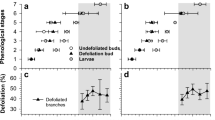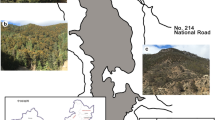Abstract
We studied the effects of repeated defoliation and drought, which are considered to be most effective in triggering oak decline, on the Central-European oak species Quercus robur L. and Quercus petraea [Matt.] Liebl. Three-year-old saplings were subjected to artificial defoliation in two consecutive years and to drought stress, applied singly or in combination. Differences in the morphological, anatomical and physiological responses to these stress factors among treatments and between species were tested in a 3-year experiment. Drought stress lowered the pre-dawn and the afternoon leaf-water potentials in both species, irrespective of additional defoliation. The relative water content of the leaves was unaffected by drought stress; but, in Q. robur, it decreased in trees subjected to defoliation and to the combination of drought stress and defoliation. When repeated defoliation and drought stress were applied within the same growing season, the leaf-to-air difference in the partial pressure of water vapour (Δw) explained most of the variation in the daily integral of the stomatal conductance to water vapour (g s day sum) in Q. petraea; however, in Q. robur, the hydraulic conductance of the twigs was the most powerful predictor variable. In the same year, the actual hydraulic conductance was correlated with g s day sum in Q. robur, but not in Q. petraea. The studied parameters of gas exchange and biomass production revealed that Q. robur recovered more rapidly from stress than did Q. petraea. We hypothesize that this is due to Q. robur‘s lower responsiveness to the environmental variable Δw and its higher responsiveness to internal hydraulic conductance compared to Q. petraea.





Similar content being viewed by others
References
Altenkirch W (1991) Zyklische Fluktuation beim Kleinen Frostspanner (Operophthera brumata L.). Allg Forst- u J-Ztg 162:2–7
Aranda I, Gil L, Pardos JA (2000) Water relations and gas exchange in Fagus sylvatica L. and Quercus petraea (Mattuschka) Liebl. in a mixed stand at their southern limit of distribution in Europe. Trees 14:344–352
Ball JT, Woodrow IE, Berry JA (1987) A model predicting stomatal conductance and its contribution to the control of photosynthesis under different environmental conditions. In: Biggins J (ed) Progress in Photosynthesis Research, vol 4. M. Nijhoff, Dordrecht, pp 221–224
Bartels C (2001) Auswirkungen von Entlaubung und Trockenstress auf das wasserleitende System junger Eichen (Quercus petraea [Matt.] Liebl. und Quercus robur L.). Diploma Thesis, Albrecht von Haller Institute of Plant Sciences, University of Göttingen
Blank R (1997) Ringporigkeit des Holzes und häufige Entlaubung durch Insekten als spezifische Risikofaktoren der Eichen. Forst Holz 52:235–242
Blank R, Hartmann G (1993) Eichensterben in Norddeutschland—Symptomatik und mögliche Ursachen. In: Bayerische Akademie für Wissenschaften (ed) Zustand und Gefährdung der Laubwälder. Rundgespräche der Kommission für Ökologie 5. Verlag Dr. Friedrich Pfeil, München, pp 45–56
Blank R, Riemer T (1999) Quantifizierung des Einflusses blattfressender Insekten auf den Spätholzzuwachs der Eiche in Nordwestdeutschland. Forst Holz 54:569–576
Block J, Delb H, Hartmann G, Seemann D, Schröck HW (1995) Schwere Folgeschäden nach Kahlfraß durch Schwammspinner im Bienwald. Allg Forst Z/Wald 50:1278–1281
Cochard H, Bréda N, Granier A, Aussenac G (1992) Vulnerability to air embolism of three European oak species (Quercus petraea [Matt.] Liebl., Q. pubescens Willd., Q. robur L.). Ann Sci For 49:225–233
Cochard H, Bréda N, Granier A (1996) Whole tree hydraulic conductance and water loss regulation in Quercus during drought: evidence for stomatal control of embolism? Ann Sci For 53:197–206
Delatour C (1983) Les dépérissements de chênes en Europe. Rev For Fr 35:265–282
Dewar RC (2002) The Ball-Berry-Leuning and Tardieu-Davies stomatal models: synthesis and extension within a spatially aggregated picture of guard cell function. Plant Cell Environ 25:1383–1398
Ellenberg H (1996) Vegetation Mitteleuropas mit den Alpen. 5th edn. Ulmer, Stuttgart
Feeny P (1970) Seasonal changes in oak leaf tannins and nutrients as a cause of spring feeding by winter moth caterpillars. Ecology 51:565–581
Gao Q, Zhao P, Zeng X, Cai X, Shen W (2002) A model of stomatal conductance to quantify the relationship between leaf transpiration, microclimate and soil water stress. Plant Cell Environ 25:1373–1381
Gieger T (2002) Auswirkungen von Trockenheit und Entlaubung auf den Wasserhaushalt von Stiel- und Traubeneiche. PhD Thesis, Faculties of Mathematics and Natural Sciences, University of Göttingen. http://webdoc.sub.gwdg.de/diss/2002/gieger/gieger.pdf
Gieger T, Thomas FM (2002) Effects of defoliation and drought stress on biomass partitioning and water relations of Quercus robur and Quercus petraea. Basic Appl Ecol 3:171–181
Gradwell GR (1974) The effect of defoliators on tree growth. In: Morris MG, Perring FH (eds) The British Oak. B.S.B.I. Conference Reports 14. Classey, Faringdon, UK, pp 182–193
Gross K, Homlicher A, Weinreich A, Wagner E (1996) Effect of shade on stomatal conductance, net photosynthesis, photochemical efficiency and growth of oak saplings. Ann Sci For 53:279–290
Gutschick VP, Simonneau T (2002) Modelling stomatal conductance of field-grown sunflower under varying soil water content and leaf environment: comparison of three models of stomatal response to leaf environment and coupling with an abscisic acid-based model of stomatal response to soil drying. Plant Cell Environ 25:1423–1434
Hartmann G (1996) Ursachenanalyse des Eichensterbens in Deutschland—Versuch einer Synthese der bisherigen Befunde. Mitt Biol Bundesanst Land- u. Forstwirtsch Berlin-Dahlem 318:125–151
Hartmann G, Blank R (1992) Winterfrost, Kahlfraß und Prachtkäferbefall als Faktoren im Ursachenkomplex des Eichensterbens in Norddeutschland. Forst Holz 47:443–452
Hartmann G, Blank R (1998) Aktuelles Eichensterben in Niedersachsen—Ursachen und Gegenmaßnahmen. Forst Holz 53:733–735
Hartmann G, Nienhaus F, Butin H (1995) Farbatlas Waldschäden; 2nd edn. Ulmer, Stuttgart
Jones HG (1998) Stomatal control of photosynthesis and transpiration. J Exp Bot 49:387–398
Katul G, Leuning R, Oren R (2003) Relationship between plant hydraulic and biochemical properties derived from a steady-state coupled water and carbon transport model. Plant Cell Environ 26:339–350
Krahl-Urban J (1959) Die Eichen. Parey, Hamburg
Leuning R (1990) Modeling stomatal behavior and photosynthesis of Eucalyptus grandis. Aust J Plant Physiol 17:159–175
Leuning R (1995) A critical appraisal of a combined stomatal-photosynthesis model for C3 plants. Plant Cell Environ 18:339–355
McGraw JB, Gottschalk KW, Vavrek MC, Chester AL (1990) Interactive effects of resource availabilities and defoliation on photosynthesis, growth, and mortality of red oak seedlings. Tree Physiol 7:247–254
Mencuccini M (2003) The ecological significance of long-distance water transport: short-term regulation, long-term acclimation and the hydraulic costs of stature across plant life forms. Plant Cell Environ 26:163–182
Meusel H, Jäger E, Weinert E (1965) Vergleichende Chorologie der zentraleuropäischen Flora. VEB G. Fischer, Jena
Nardini A, Salleo S (2000) Limitation of stomatal conductance by hydraulic traits: sensing or preventing xylem cavitation? Trees 15:14–24
Nykänen H, Koricheva J (2004) Damage-induced changes in woody plants and their effects on insect herbivore perfomance: a meta-analysis. Oikos 104:247–268
Ohnesorge B (1991) Tiere als Pflanzenschädlinge, 2nd edn. Thieme, Stuttgart New York
Oren R, Sperry JS, Katul GG, Pataki DE, Ewers BE, Phillips N, Schäfer KVR (1999) Survey and synthesis of intra- and interspecific variation in stomatal sensitivity to vapour pressure deficit. Plant Cell Environ 22:1515–1526
Ponton S, Dupouey J-L, Bréda N, Dreyer E (2002) Comparison of water-use efficiency of seedlings from two sympatric oak species: genotype × environment interactions. Tree Physiol 22:413–422
Rubtsov VV (1996) Influence of repeated defoliations by insects on wood increment in common oak (Quercus robur L.). Ann Sci For 53:407–412
Sachs L (1984) Applied Statistics—a Handbook of Techniques. Springer, Berlin Heidelberg New York
Schlag MG (1994) Das europäische “Eichensterben” und seine Ursachen—von einem phytopathologischen Standpunkt aus gesehen. Cbl ges Forstwes 111:243–266
Shapiro SS, Wilk MB (1965) An analysis of variance test for normality (complete samples). Biometrika 52:591–611
Slavik B (1974) Methods of Studying Plant Water Relations. Ecological Studies vol 9. Springer, Berlin Heidelberg New York
Sperry J (2000) Hydraulic constraints on plant gas exchange. Agricult For Meteorol 104:13–23
Sperry JS, Saliendra NZ (1994) Intra- and inter-plant variation in xylem cavitation in Betula occidentalis. Plant Cell Environ 17:1233–1241
Sperry JS, Donnelly JR, Tyree MT (1988) A method for measuring hydraulic conductivity and embolism in xylem. Plant Cell Environ 11:35–40
Sperry JS, Hacke U, Oren R, Comstock JP (2002) Water deficits and hydraulic limits to leaf water supply. Plant Cell Environ 25:251–263
Svolba J, Kleinschmit J (2000) Herkunftsunterschiede beim Eichensterben. Forst Holz 55:15–17
Tardieu F, Davies WJ (1993) Integration of hydraulic and chemical signalling in the control of stomatal conductance and water status of droughted plants. Plant Cell Environ 16:341–349
Thomas FM (1998) State of knowledge in cause-effect research on damage to oak and beech in Europe. In: Augustin S, Andreae H (eds) Cause-Effect Interrelations in Forest Condition—State of Current Knowledge. UN/ECE International Co-operative Progamme Forests. Federal Research Centre for Forestry and Forest Products, Hamburg, pp 14–20
Thomas FM (2000) Growth and water relations of four deciduous tree species (Fagus sylvatica L., Quercus petraea [Matt.] Liebl., Q. pubescens Willd., Sorbus aria [L.] Cr.) occurring at Central-European tree-line sites on shallow calcareous soils: physiological reactions of seedlings to severe drought. Flora 195:104–115
Thomas FM, Gausling T (2000) Morphological and physiological responses of oak seedlings (Quercus petraea and Q. robur) to moderate drought. Ann Sci For 57:325–333
Thomas FM, Hartmann G (1998) Tree rooting patterns and soil water relations of healthy and damaged stands of mature oak (Quercus robur L. and Quercus petraea [Matt.] Liebl.). Plant Soil 203:145–158
Thomas FM, Schafellner C (1999) Effects of excess nitrogen and drought on the foliar concentrations of allelochemicals in young oaks (Quercus robur L. and Q. petraea [Matt.] Liebl.). J Appl Bot 73:222–227
Thomas FM, Blank R, Hartmann G (2002) Abiotic and biotic factors and their interactions as causes of oak decline in Central Europe. For Path 32:277–307
Tuzet A, Perrier A, Leuning R (2003) A coupled model of stomatal conductance, photosynthesis and transpiration. Plant Cell Environ 26:1097–1116
Tyree MT (2003) Hydraulic limits on tree performance: transpiration, carbon gain and growth of trees. Trees 17:95–100
Tyree MT, Cochard H (1996) Summer and winter embolism in oak: impact on water relations. Ann Sci For 53:173–180
Vivin P, Aussenac G, Lévy G (1993) Differences in drought resistance among 3 deciduous oak species grown in large boxes. Ann Sci For 50:221–233
Acknowledgements
T. Gieger thanks the Deutsche Bundesstiftung Umwelt for funding part of this study by a PhD grant.
Author information
Authors and Affiliations
Corresponding author
Rights and permissions
About this article
Cite this article
Gieger, T., Thomas, F.M. Differential response of two Central-European oak species to single and combined stress factors. Trees 19, 607–618 (2005). https://doi.org/10.1007/s00468-005-0424-5
Received:
Accepted:
Published:
Issue Date:
DOI: https://doi.org/10.1007/s00468-005-0424-5




